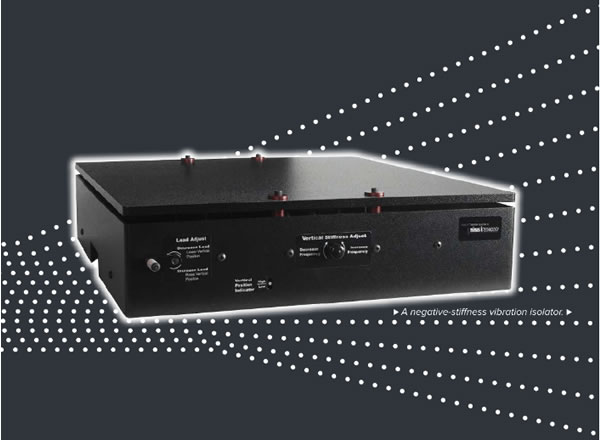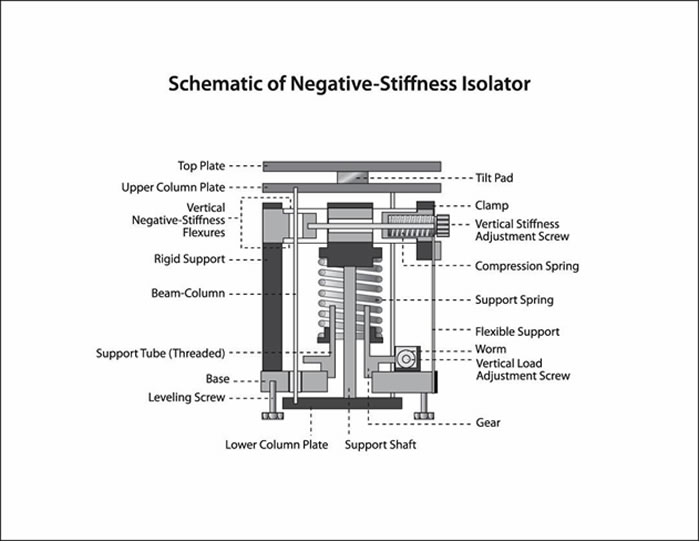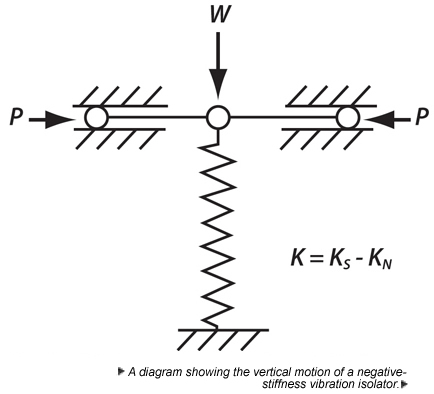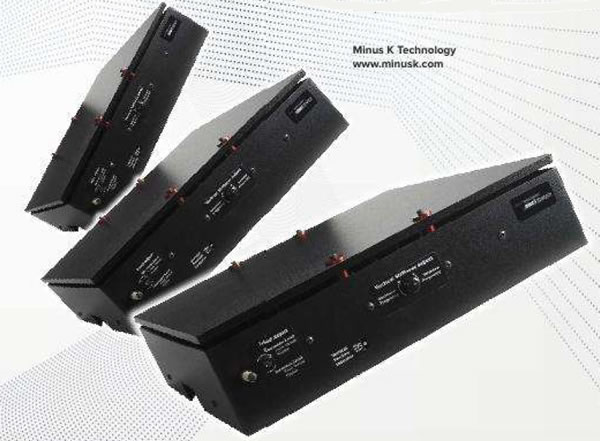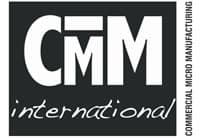
Commercial Micro Manufacturing - December 2020
Negative-stiffness versus active vibration isolation for critical nano-precision applications
DR. DAVID L. PLATUS, PRESIDENT AND FOUNDER OF MINUS K TECHNOLOGY
The need for nano- precision has became increasingly important in many fields of research and manufacturing, inducing microelectromcs fabrication, laser/optical system applications and biological research. This has meant that so too has the need for vibration Isolation technology that better facilitates the operation of sensitive Instrumentation such as atomic force microscopes, scanning tunneling microscopes laser interferometers and optical profilers.
Once the mainstay for stabilizing academia's and Industry's most critical microenginering instrumentation, pneumatic (gas or air pressurized) vibration Isolation tables are today proving unsatisfactory in isolating disruptive low-frequency vibrations. There is a growing trend for locating sensitive instrumentation in building to locations that are subject to extremely high levels of vibration and this is a significant stumbling block for pneumatic vibration isolation tables, meaning alternative vibration isolation solutions are required.
Vibration sources
Nano-level instrumentation is sensitive to extremely small payload vibrations that can be caused by a multitude of factors. Every structure (building) transmits vibrations from Internal and external sources In a building, heating and ventilation systems, fans, pumps and elevators are Just some of the mechanical devices that create vibrations. Outside a building, adjacent road traffic, nearby construction, aircraft and even wand and other weather conditions all create vibrations How strongly the instrumentation is influenced depends on where it is in the building and how far away it is from the vibration sources.
Isolation for vibration critical applications
Over the past 25 years, two technologies have gained prominence for their ability to Isolate vibrations Influencing nano-level Instrumentation, namely active vibration isolation (also known as electronic-force cancellation) and negative-stiffness vibration isolation {also known as passive vibration isolation).
Both active and negative-stiffness vibration isolation are uniquely equipped for applications where structures smaller than a micrometre need to be produced or measured. These technologies provide functionality that is typically not achievable with pneumatic vibration isolation tables.
Active vibration isolation
Active vibration Isolation systems have been used for the better part of half a century, but became popular for precision applications m the mid-1990s due to the advent of more sophisticated electronics and controllers.
These systems use electronics to sense motion and then apply corrective forces to cancel out the vibrations. They employ a combination of sensors, transducers and actuators that are directed by algorithms to attenuate the vibrations. The sensors detect vibrations along the X, Y and Z axes and send this information to a controller that then sends a signal to the actuators to reduce the vibrations.
Active vibration Isolation systems use feedback control but may also use feedforward control to attenuate vibrations. A feedback active control system continuously monitors the platform it is controlling and modifies its output according to the vibration data retrieved. Specifically, it measures the forces causing the vibrations and sends out corrective signals to transducers to reduce them.
A feedforward active control system responds in a predefined way to control the input vibrations. This type of control system is deployed if the behaviour of the controlled forces (vibrations) is well understood, such as in the case of impulses from stage motions, valves, etc. The feedforward active control system already has information about the motion and applies the necessary forces to counter the vibrations.
A feedback active control system must balance a complexity of inertial feedback in response to incoming vibrations in order to achieve a high level of precision. This can be challenging If the initial feedback is applied to incoming low-frequency vibrations horizontally,
Both feedback and feedforward active control systems operate using a six degree-of-freedom (DOF) orientation, consisting of three linear and three rotational axes. The horizontal DOFs, controlled using horizontally-driving actuators (X, Y and yaw}, pose a problem in tilt to horizontal coupling When a payload is pushed sideways with horizontal actuators and it tilts, the inertial sensors read the tilt and try to correct it by accelerating the payload. This can produce unwanted results, from a degradation in performance to actually adding vibration.
Negative-stiffness vibration isolation
Negative-stiffness vibration isolators were introduced in the mid-1990s, and they have excelled in popularity for vibration-critical applications, largely because of their ability lo effectively isolate lower frequency vibrations both vertically and horizontally.
These isolators operate entirely differently to active vibration isolation systems, namely in a passive mechanical mode that does not require the use of air or electricity and therefore electronics, motors or pumps.
Negative-stiffness vibration isolation for vertical motion is provided by a stiff spring that supports a weight load, combined with a negative-stiffness mechanism. The net vertical stiffness is made very low without affecting the static load-supporting capability of the spring. Beam-columns connected in series with the vertical-motion isolator provide horizontal-motion isolation. A beam-column behaves as a stiff spring combined with a negative-stiffness mechanism.
Negative-stiffness vibration isolators deliver very high performance, as measured by a vibration transmissibility curve. Vibration transmissibility is measure of the vibrations that are transmitted through the isolator relative to the input vibrations.
Negative-stiffness vibration isolators typically resonate at 0.5 Hz. Most buildings have little vibration in this region. It would be very unusual to find a significant vibration at 0.5 Hz. Vibrations with frequencies above 0.7 Hz are rapidly attenuated with increases in frequency. When adjusted to 0.5 Hz. negative-stiffness vibration isolators achieve approximately 93 percent isolation efficiency at 2 Hz, 99 percent at 5 Hz and 99.7 percent at 10 Hz.
Negative-stiffness vibration isolators provide natural frequencies of 0.5 to 1.5 Hz horizontally (depending on the model) and 0.5 Hz vertically. They have the flexibility of custom tailoring higher resonant frequencies when lower ones are not required.
*Note that for an isolation system with a 0.5 Hz natural frequency, isolation begins at 0.7 Hz and improves with increase in the vibration frequency. The natural frequency is more commonly used to describe the system performance.
Comparing the systems
Both active vibration isolation systems and negative-stiffness vibration isolators have operating features and capabilities that may make one more suited for an application over the other. Below are some additional comparisons to consider.
Dynamic range
An active vibration isolation system has a limited dynamo range. It smuggles to accommodate vibration input that is either too large or too small. Vibrations that are too large can cause the system to go into positive feedback, and vibrations that are too small may not even be detected.
A negative-stiffness vibration isolator has significant dynamic range, that is to say it delivers higher levels of isolation throughout most of the frequency spectrum. It works on vibrations from essentially zero up to amplitudes of about +/- 0.1 in. or more, depending on the model.
A negative-stiffness vibration isolator can be placed on any typical laboratory table without compromising its ability to isolate vibrations.
Component noise
An active vibration Isolation system is subject to the noise-floor of every component in the feedback loop. This includes sensors, transducers, actuators, amplifiers, etc. This limits how well an active vibration isolation system can work in low vibration environments and ultimately, how much isolation it can provide.
A negative-stiffness vibration isolator does not use any of the aforementioned components and is therefore not subject to the same limitations.
Cabling
An active vibration isolation system can help with vibrations coming up though cables that are unusually stiff. It is always important to deal with cabling. Most cables, if run properly will not cause problems by transmitting vibrations but sometimes cables are quite stiff or cannot be run in a flexible manner. A negative-stiffness vibration isolator may help to remove some of chose vibrations.
Adjusting for payloads
An active vibration isolation system performs most of the payload adjustments automatically when switched on. A negative-stiffness isolator requires a simple manual adjustment whenever the payload changes.
Location flexibility
An active violation isolation system must be on very rigid structures to work at their theoretical best. If it is placed, for example, on a 100-pound light-duty laboratory table that has a 250-pound instrument on top, problems with isolating vibrations may occur. An active vibration isolation system works by applying force to the payload in an attempt to minimize vibrations. Where the payload weighs more than the table and/or the table is not very rigid, the table will move when corrective force is applied. This can result in poor performance.
A negative-stiffness vibration isolator can be placed on any typical laboratory table without compromising its ability to isolate vibrations. It affords very high isolation efficiencies with regards to low-hertz vibrations in both vertical and horizontal vectors, enabling sensitive instruments to be located anywhere a production facility or laboratory is set up, be that in a basement or on a vibration-compromised sixth floor.
Minus K Technology
www.minusk.com
|
